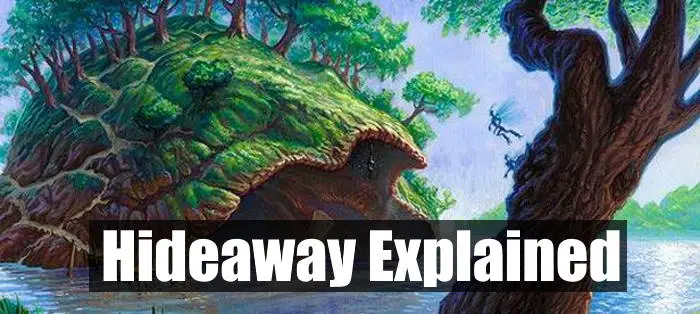Magic: the Gathering is one of the most complex games in the entire world. Part of the reason for this complexity is the ever growing number of abilities and mechanics. Today I’m going to talk about one of these mechanics: Hideaway.
Hideaway is a keyword ability first introduced in Lorywn. Whenever a permanent with Hideaway enters the battlefield, you may look at the top N cards of your library and exile a card from among them face down. The Hideaway card then gives you access to the exiled card later in the game if certain conditions are met.
Each Hideaway card has its own value, as well as its own requirements for casting the exiled card. There’s a lot to go over whenever your dealing with such a varied mechanic. But not to worry. In this article, I’ll answer any and all questions you might have. Let’s jump right in.
What Is Hideaway?
Hideaway is a keyword ability first used in Lorwyn and used most recently in Streets of New Capenna. Hideaway is followed by a number. For example, a permanent might have “Hideaway 4”. In this case, whenever the card enters the battlefield, you look at the top four cards of your library, and you get to exile one of those cards face down.
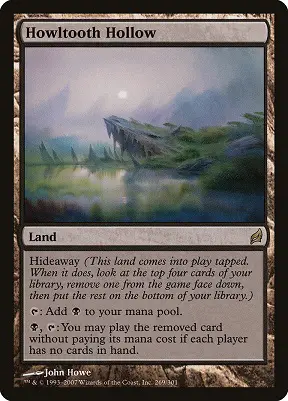
How Does It Work?
As mentioned above, whenever a card with Hideaway enters the battlefield, you look at the top N cards of your library (N is equal to the number following the Hideaway ability). You choose one of those cards and exile it face down. You put the rest of the cards on the bottom of your library. So now you have a card exiled face down. But how can you use it? Well, that depends on the specific Hideaway card. Let’s use Rabble Rousing for example.
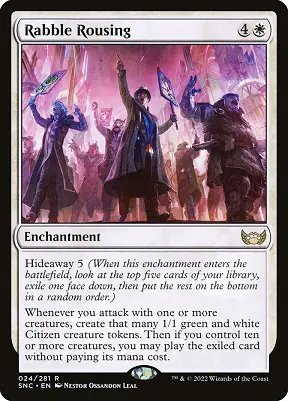
If you can get ten or more creatures at once, Rabble Rousing gives you access to your exiled card. It also lets you cast that card for free! To help out with this requirement, Rabble Rousing gives you a 1/1 Citizen creature token any time you attack with a creature.
Let’s take a look at another example. Watcher for Tomorrow gives you access to the exiled card whenever he leaves the battlefield. Instead of being able to cast it from exile, however, Watcher brings the card into your hand.
As you can see, Hideaway functions very differently depending on the card. However, you know for sure that you’ll get to look at a certain number of cards, exile one of them, and then have a chance to use that card later.
Can You Play Lands With Hideaway?
Yes, you can exile and play lands with the Hideaway ability! Hideaway states that you may “play” the exiled card. Since it doesn’t say that you have to “cast” the card, this means lands are fair game.
RELATED: Boast: All Your Questions Answered
Does playing Spells Exiled With Hideaway Count As Casting?
Yes, if you play a spell that has been exiled by a Hideaway ability, that spell is cast. This will trigger any “cast” abilities that the card itself may have (ie. Emrakul, the Aeons Torn). It also triggers any “cast” abilities from permanents on the field. For example if you play a non-creature spell exiled by a Hideaway ability while Monestary Switspear is on your side, you’ll get a Prowess trigger.
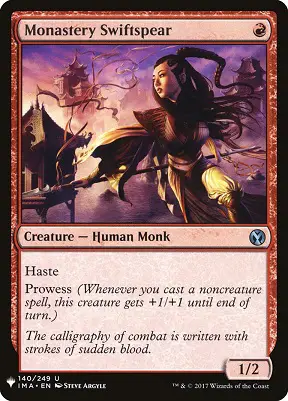
There is some confusion about this on the internet, with some websites explaining this rule incorrectly. The confusion likely comes from Hideaway spells stating that you may “play” the exiled spell, instead of using the word “cast”. This distinction, however, was made to allow players to “play” lands using the ability. The way Hideaway functions, you can play any card exiled with the ability in whatever ways possible. If the card is a land, you just “play” it. If the card is a normal spell, playing it means you’ll “cast” it.
Can You Cast Hidden Spells At Instant Speed With Hideaway?
Well, yes and no. The is actually a pretty complicated question. To help simplify it. I’ll break it up into two sections.
Original Hideaway Land Cycle From Lorwyn
The original Hideaway lands from Lorwyn let you cast your exiled card via activated abilities. And since activated abilities can be used any time you have priority, this means that those cards do allow you to cast the exiled card basically at instant speed. This is true even if the card is a sorcery or a creature. The exception to this, however, is Windbrisk Heights which requires you to have attacked with at least three creatures that turn for you to activate it. This restrictions means that you can only activate the ability during your turn.
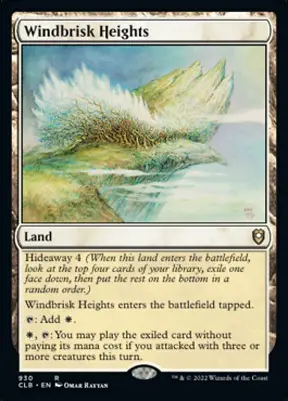
Playing lands that have been exiled with Hideaway is also a different story. You can, of course, only play lands during your turn, and only if you haven’t played one already. The Hideaway ability does not change these fundamental rules.
Cycle From Streets of New Capenna
The new enchantments with Hideaway function a bit differently than the old Hideaway cards. These enchantments all have a triggered ability that helps you meet the requirement for casting your hidden card. The way it’s worded, casting the exiled card is actually a part of these triggered abilities. For example, Rabble Rousing says: “Whenever you attack with one or more creatures, create that many 1/1 green and white Citizen creature tokens. Then, if you control ten or more creatures, you may play the exiled card without paying its mana cost.” This means that the exiled card can only be played after the first step of the triggered ability is finished, and if the requirements are met.
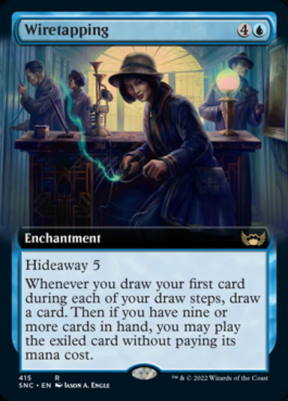
With that being said, however, the Hideaway ability does ignore the regular timing of spells. For example, if you have a sorcery card exiled with Rabble Rousing, after the triggered ability triggers, you can then cast the sorcery during combat, which you wouldn’t be able to do under normal circumstances.
Note: There is one card that falls outside of either of these two sections: Watcher for Tomorrow. This card, however, doesn’t let you cast the exiled card, so the timing question doesn’t apply. Instead, it lets you put the exiled card into your hand. After that, you play it just like any other card, following all of the usual timing restrictions.
Can You Counter Hidden Spells Played With Hideaway?
Yes, players can counter hidden spells that are being cast with Hideaway. These spells still use the stack which means players can respond to them normally.
RELATED: MTG Foretell: How It Works and What It Does
What If a Card Exiled With Hideaway Has X In Its Casting Cost?
If you exile a spell with X in its cost with the Hideaway ability, X will be zero when you play that card. With that being said, you should probably think twice before choosing those types of cards. You can, however, pay any additional casting costs the hidden card might have.
Rules Change
With the release of Streets of New Capenna, Wizards of the Coast announced a change to the mechanic. Previously, Hideaway never had a number. The ability simply meant that you look at the top four cards of your library and choose one to exile. It also used to mean that the card with Hideaway entered the battlefield tapped.
With Streets of New Capenna, however, Wizards decided to drop the “enters the battlefield tapped” restriction. Wizards updated the text of the original Hideaway cards so that the restriction was separate from the ability. They also decided to give Hideaway different numbers, instead of having it always be four. So the old cards were changed to have “Hideaway 4”,and the new cycle of cards were given “Hideaway 5”.
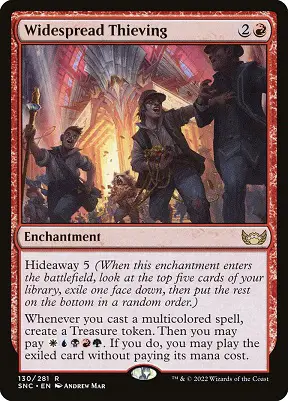
RELATED: MTG Shield Counters: How They Work and What They Do
Full Card List
So far, there are 13 cards with the ability: Five lands from Lorywn, one creature from Modern Horizons, five enchantments from Streets of New Capenna, and one Vehicle from the Streets of New Capenna Commander Precon.
- Howltooth Hollow
- Mosswort Bridge
- Shelldock Isle
- Spinerock Knoll
- Windbrisk Heights
- Watcher for Tomorrow
- Smuggler’s Buggy
Best Cards
Fight Rigging
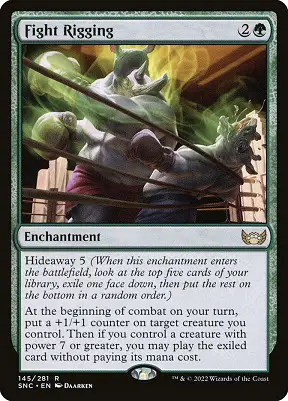
Fight Rigging is a three-mana enchantment with Hideaway 5 that lets you put a +1/+1 counter on target creature you control every combat. Then, if you control a creature with power seven or greater, you get to cast your hidden card for free. Fight Rigging could be a solid card in the right Standard creature-based decks. Getting a +1/+1 counter every turn, plus getting a completely free spell later on? Sounds good to me.
Cemetery Tampering
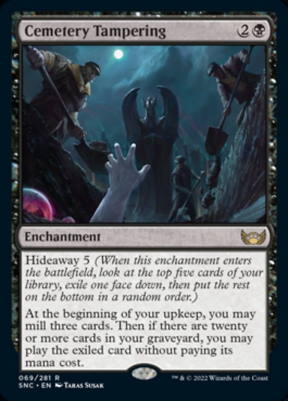
Cemetery Tampering is a three-mana enchantment that requires you to have 20 or more cards in your graveyard to play your hidden spell for free. To help with this goal, Cemetery Tampering lets you mill three cards every turn on your upkeep. I see this card being great in graveyard strategies, mainly in Commander where players can quickly fill their graveyards. And where the free-spell payoffs can be huge.
Spinerock Knoll
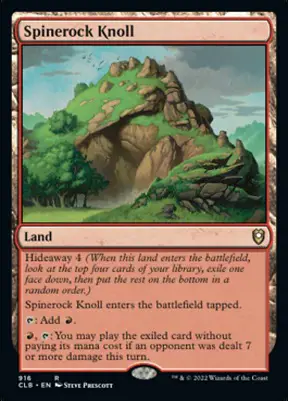
To play your hidden card, Spinerock Knoll requires you to deal seven damage to a player in one turn. Aggressive decks should have no problem with that. The issue, however, is that Spinerock Knoll comes into play tapped, something that aggressive decks don’t want to happen. Also, in most formats, decks that can easily deal seven damage in a single turn are usually pretty low-to-the-ground. This means they might not have a big powerful spell to hideaway, making the whole thing just not worth the trouble. Spinerock Knoll, however, is quite good in Commander, where it’s easier to meet the requirement, and the rewards are potentially much bigger. There’s little else as fun as exiling a giant bomb of a spell and then playing it for free.
Shelldock Isle
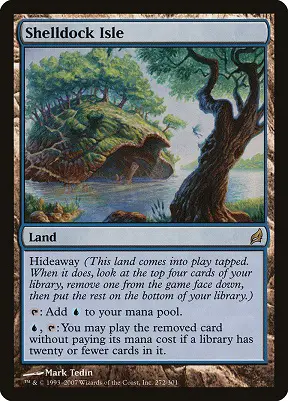
Like the other Lorywn lands, Shelldock Isle lets you hide a card away and play it for free if you meet certain requirements. Shelldock Isle requires a library to have 20 or fewer cards for you to get the free card. In decks that try to win by making their opponents mill cards, It’s easy to meet this requirement. Consistently getting a free spell is a big deal for mill, and Shelldock Isle is often the difference maker in close games.
Watcher for Tomorrow
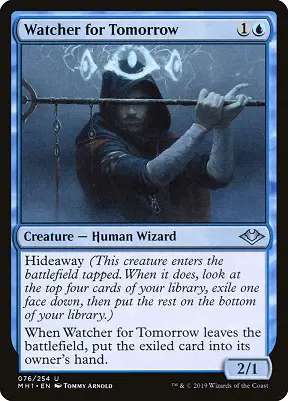
The only creature with Hideaway,Watcher for Tomorrow is my pick for the best card featuring the ability. For two mana (one and a blue), you a get 2/1 creature with Hideaway 4. The best part about Watcher is that, unlike other cards on this list, you almost always end up getting the hidden card. Whenever Watcher for Tomorrow leaves the battlefield you get to put the exiled card into your hand. So even if your opponent removes him, you still get the card. Watcher for Tomorrow really starts to get crazy in “blink” strategies. If you can find a way to bounce him, you get to add the exiled card to your hand when he leaves, and then exile ANOTHER card when he comes back in.
End Step
There’s little else in the game of Magic as satisfying as playing cards for free. So it’s no wonder that Hideaway has proven to be a fun and useful mechanic across a variety of formats. I hope this article has answered all of your questions about this exciting, yet complicated, mechanic. If not, feel free to post a question in the comments. I’ll be happy to answer it. Until next time, I wish you the best of luck playing all of your cards, hidden or otherwise.
